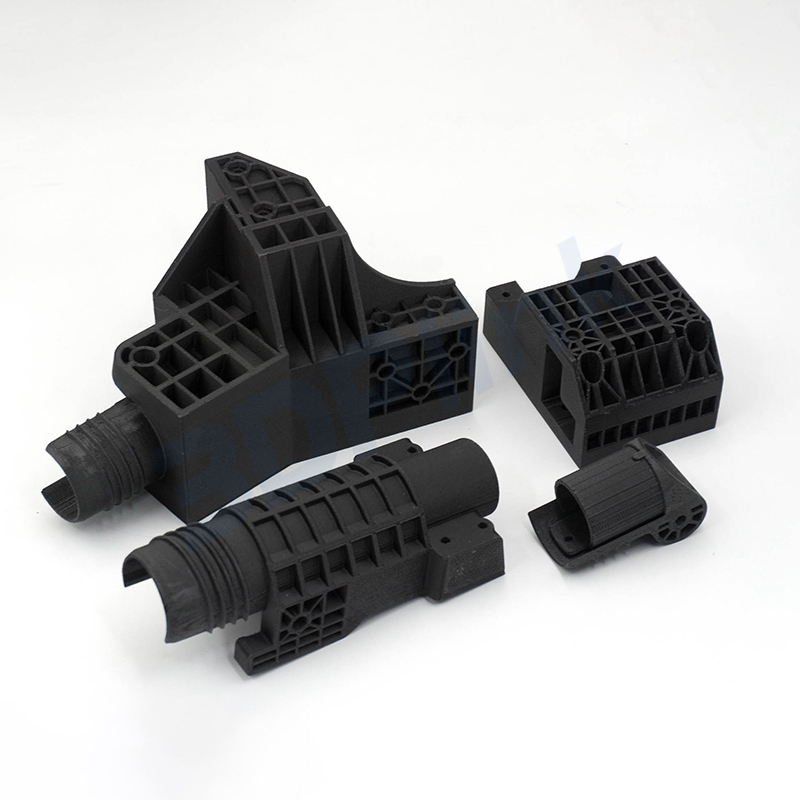The 3D printing market has rapidly expanded from the various industry. From small, costly machines to industrial-grade operations, 3D printing hardware continues to be refined, though at a much more gradual pace. The next major frontier for the industry is improving the materials we use to create more resistant, flexible, and usable parts and components.
One of the more interesting developments in recent years is the introduction of 3D printable nylon, which delivers several noteworthy benefits and can be combined with other ingredients to create better products from the printing process.
 FDM Nylon 12CF (carbon filled) features the highest strength-to-weight ratio and stiffness of any FDM material.
FDM Nylon 12CF (carbon filled) features the highest strength-to-weight ratio and stiffness of any FDM material.
What Printing Methods is Nylon Good For?
A major benefit of using nylon in printing is that it allows for a variety of printing methods.
- Fused Deposition Modeling (FDM): This is one of the more common printing methods and uses nylon filament threads as the input. With FDM, it’s easy to print and create prototypes, though nylon’s moisture-absorbing properties make it harder to create smooth finishes. To get the best results, the filament should be dried before use to avoid moisture affecting the print.
- MultiJet Fusion (MJF): This method uses powder-based materials but instead of lasers, it uses selective heating and several jets that can be moved to specific areas as needed for the print. This reduces the need for extensive drying of materials, but it still requires a relatively moisture-free space to obtain the best results.
- Selective Laser Sintering (SLS): SLS allows for precision and can use several types of nylon as well as composite materials. This method supports highly complex builds but thermal distortion can be a problem, leading to shrinking and warping.
What are the Types of 3D-Printed Nylon Materials?
When it comes down to selecting the right nylon variant for printing, there are a few main types to consider based on your needs:
- Nylon 11: also known as Polyamide 11 (or PA 11), this type of nylon is known for its flexibility and impact strength. This makes it ideal for aerospace parts, as well as printing ducts and tubing in motor sports and construction work. PA 11 is also preferred sometimes due to its low moisture absorbance, making it easier to work with.
- Nylon 12: One of the biggest benefits of Nylon 12 is that it features a lower melting point than other polyamides, making it easier to work with. Additionally, it has high fatigue resistance and toughness. It’s commonly used in snap-fit closures, tools that use press-fit inserts, and parts that will receive heavy vibrations.
- Nylon 6: Nylon 6 is commonly used for FDM printing, and it is known for its strength and toughness, as well as its impact resistance. It also offers slightly more flexibility and bend than Nylon 12, though at the expense of moisture and chemical resistance.
In addition to these base types, nylon is incredibly popular due to the ease with which it can be combined with other materials for different needs. Companies like Stratasys and Stratasys Direct offer highly specialized variations of nylon printing materials for different printing methods and production requirements. Some of the most common combinations include:
- Carbon-fiber filled nylon: one of the most popular combinations for nylon materials is carbon fiber filling. CF Nylon, as it is known across the industry, offers many of the same benefits as standard nylon including high strength and stiffness, but it produces significantly lighter components that are ideal for lighter tools, functional prototyping, and some end-user components.
- Glass filled nylon: Glass filled nylon is commonly used for SLS printing and feature high rigidity as well as mechanical strength. Additionally, glass filled nylons are harder and tougher, offering tability and fatigue resistance. This makes the material ideal for parts that are exposed to static loads over long time frames in places with high heat conditions. Despite this, their more abrasive finish means they’re less suited for sliding components.
- Aluminum filled nylon: Also known as alumide, aluminum filled nylon is known for its metallic finish, its stiff nature, and its post-processing qualities. The material is commonly used with SLS printing, as it provides dimensional accuracy, a balance of density to stiffness, and beneficial heat conduction. Alumide is usually applied to stiff parts that look metallic like car components, tool inserts, and for illustrative models.
- Flame retardant nylon: While this is more standard than the filled nylon materials, it includes flame-retardant additives that makes it ideal for a more specialized set of applications. This includes commercial, military, and civil airplane interiors that require flame retardant parts by law. The material passes standard vertical burn, smoke, and toxicity requirements. It is available in both Nylon 11 and Nylon 12 varieties.
Choosing the Right Nylon Print Material for the Right Job
It’s important to remember that each of these materials is better suited for different tasks and printing methods. When it comes to selecting the perfect nylon option, companies like Stratasys offer different variations of the same materials, empowering users to uncover the best possible materials for the task at hand.
 FDM Nylon 12CF (carbon filled) features the highest strength-to-weight ratio and stiffness of any FDM material.
FDM Nylon 12CF (carbon filled) features the highest strength-to-weight ratio and stiffness of any FDM material.